Optimising your content for featured snippets and preparing for the future
Featured snippets and their predecessors have been around for years, but they still present plenty of opportunities for increasing traditional search traffic and capitalising on the future of voice search.
In this article, we are going to investigate the following featured snippet questions:
- How to improve on position one.
- What are featured snippets?
- What types of featured snippets are there?
- Why are featured snippets so important for SEO?
- How do you find featured snippet opportunities?
- How do you optimise content for featured snippets?
The (other) top position in Google
At a basic level, the objective of SEO is to get to number one for as many keywords as possible. After all – generally speaking — the higher your website appears in the SERPs, the more organic traffic you get.
This is demonstrated by the most overused chart in the history of SEO, shown below:
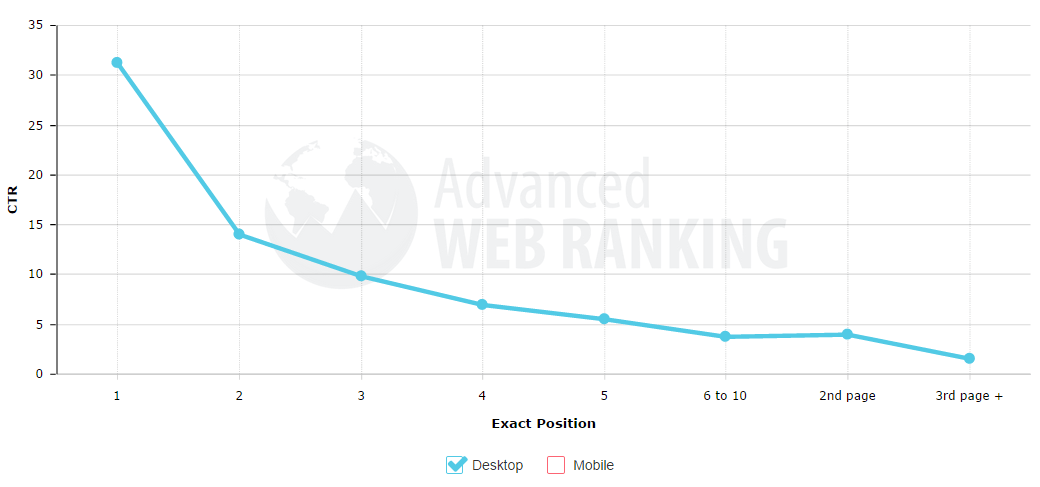
Position one has always been the epitome of organic search. With positions higher reserved for businesses that are willing to pay up for a paid listing.
Yet, growing over the last few years is the emergence of the new highest position — position zero.
Position zero refers to featured snippets. A new search result format, that appears above the traditional organic blue links.
What are featured snippets?
The first iterations of featured snippets started to appear around 2012. Before, they were referred to as “quick answers” or “answer boxes”.
However, in 2016, Google officially named them featured snippets — defined as “special boxes where the format of regular listings is reversed, showing the descriptive snippet first”.
An example of a featured snippet is shown below for the result for the search query “how cold does it get in the UK?”
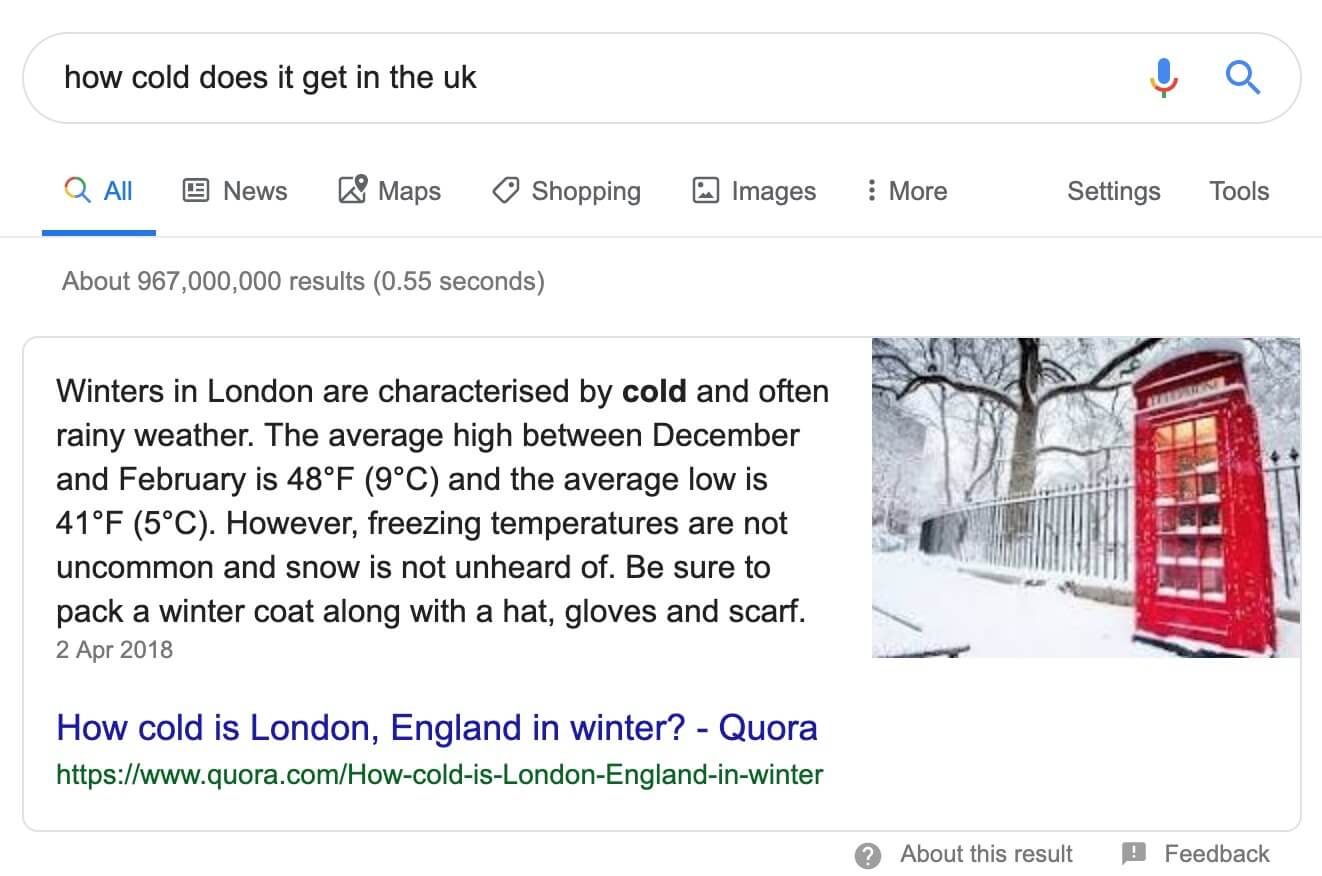
The snippet box is now the first search result to appear under the search bar.
Initially, featured snippets attracted criticism from webmasters, with complaints surrounding the fear that they lowered CTRs.
While this may have some truth, it is truly dependant on the type and result of the featured snippet that is being offered.
What types of featured snippets are there?
Although featured snippets don’t appear for every search term, they are most prominent when a question is asked, or when users search for process solutions or guides.
At the time of writing, there are five ‘types’ of featured snippets that appear to best answer question or query-based searches.
Paragraph Snippet
This is the most typical featured snippet, as seen in the previous image for “how cold does it get in the UK”.
In response to the search query, a short answer sometimes includes a featured image. The written answer should provide enough information to give a good answer to the initial search term.
It is important to note, that sometimes the text and the image can be pulled from two unrelated sources.
The URL for the source of each of the content is also included and can allow the user to click through to the website like any other search.
Numbered List Snippet
This is very similar to the paragraph featured snippet, except that the answer is structured as a numbered list.
Numbered list featured snippets offer similar information to a paragraph, but provide information in a step-by-step or ordered list.
These are normally copied directly from the source; if you include high-quality content in numbered lists on your website, expect Google to consider these for featured snippets, and copy them word for word.
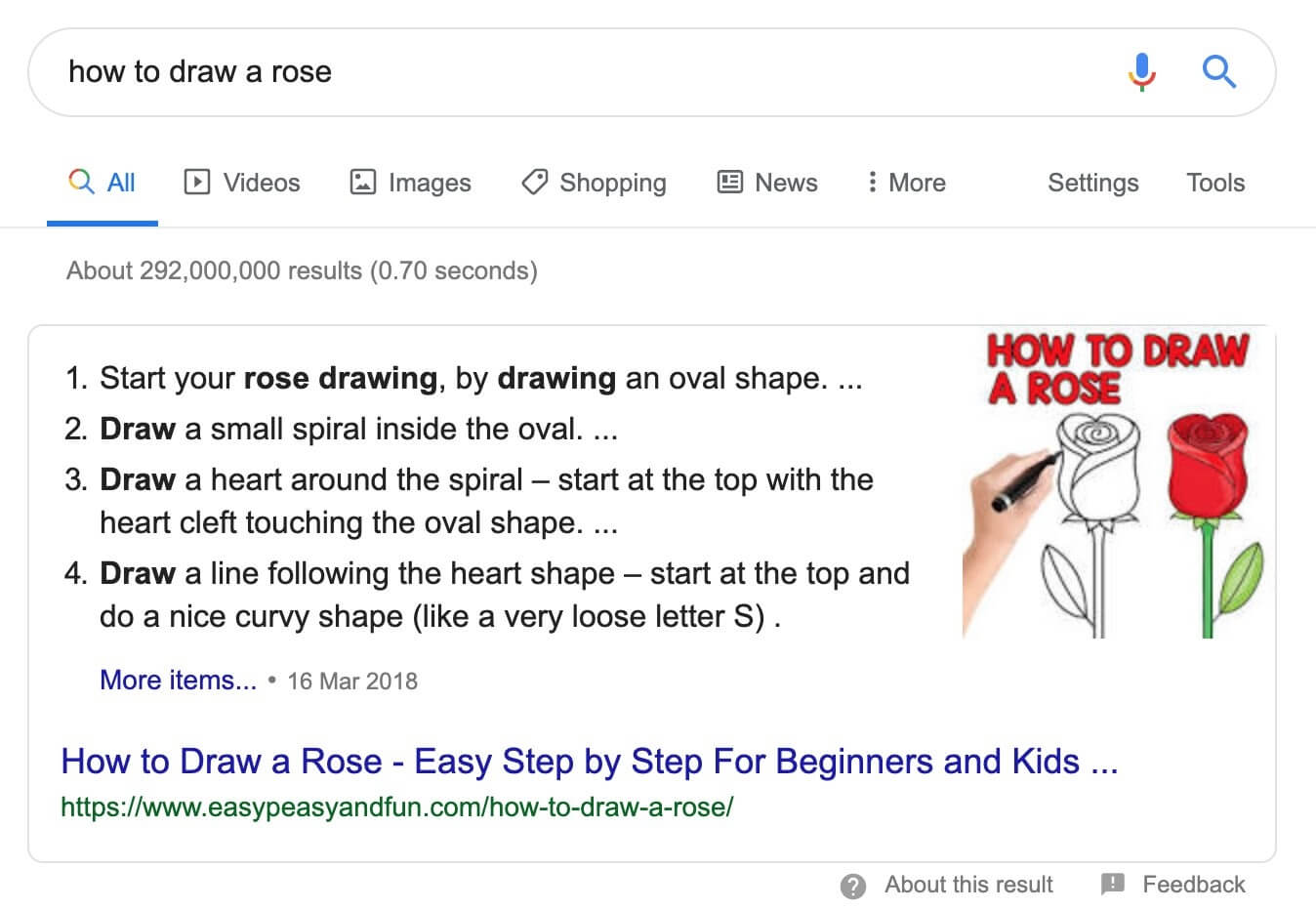
Bulleted List Featured Snippet
These featured snippets are similar to numbered lists, but are self-generated by google.
While numbered lists are usually copied directly from content, bulleted lists can also be copied and self-generated.
If Google identifies a relevant piece of content, it will use headings implementing heading tags, and create a bulleted list from the content.
Youtube Featured Snippet
Video is a powerful and convenient way to provide information and offers a great solution to users.
Google is clever enough to decide which video to serve, before then a suggesting clip from that same video to answer a query.
By adding video structured data, you can assist Google in telling it what the content is about.
An example of a video featured snippet can be seen for the search query “how to plant a seed”.
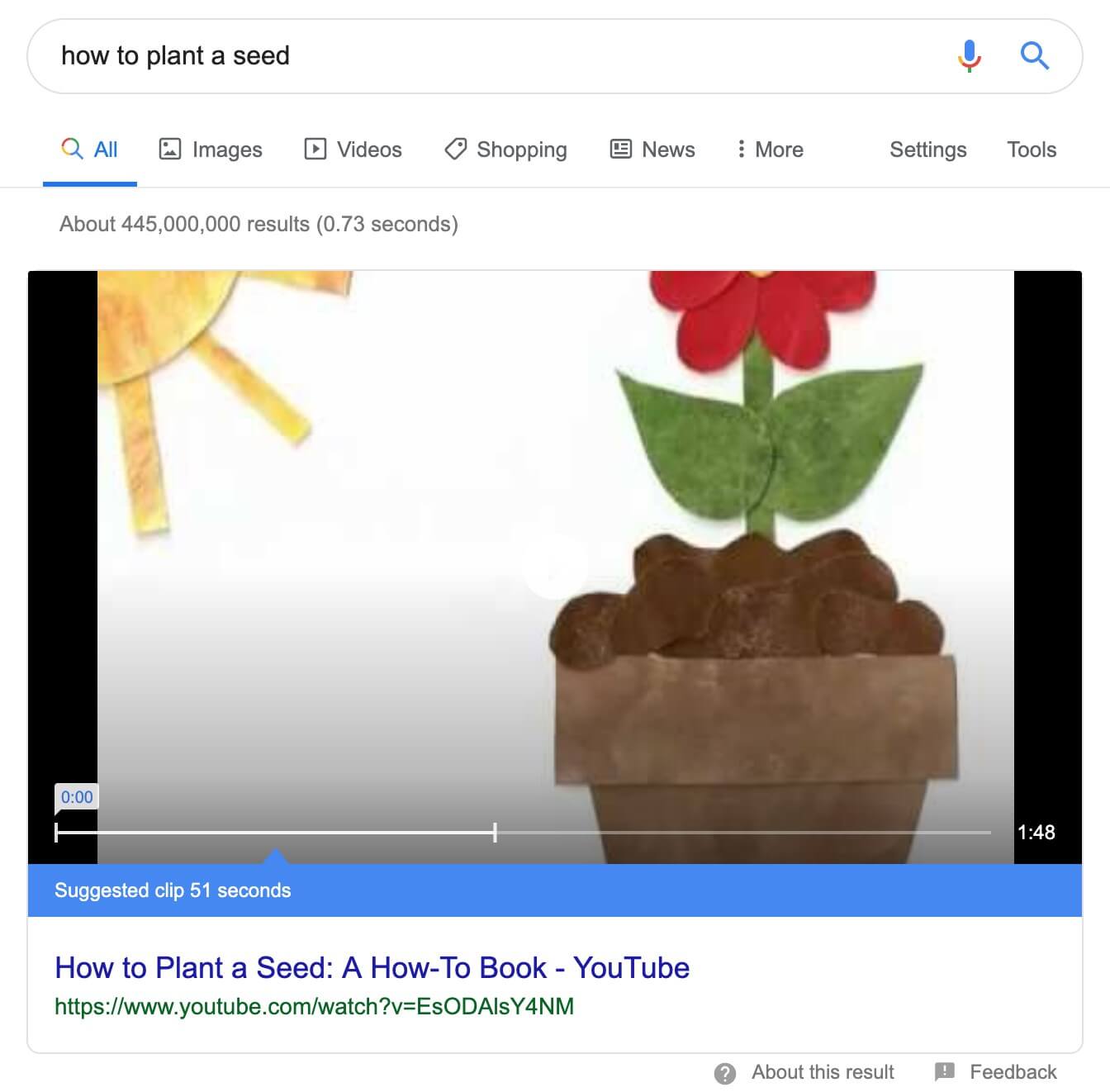
Furthermore, Google has even been known to use the video description as information for a paragraph featured snippet.
Table Featured Snippet
Table featured snippets are ways in which Google displays data that is comparable.
While Google can use content that is already in the form of a table from the source URL, it is also advanced enough to generate its own tables for the form of a featured snippet.
An example of this is a table comparing the UK interest rate history:
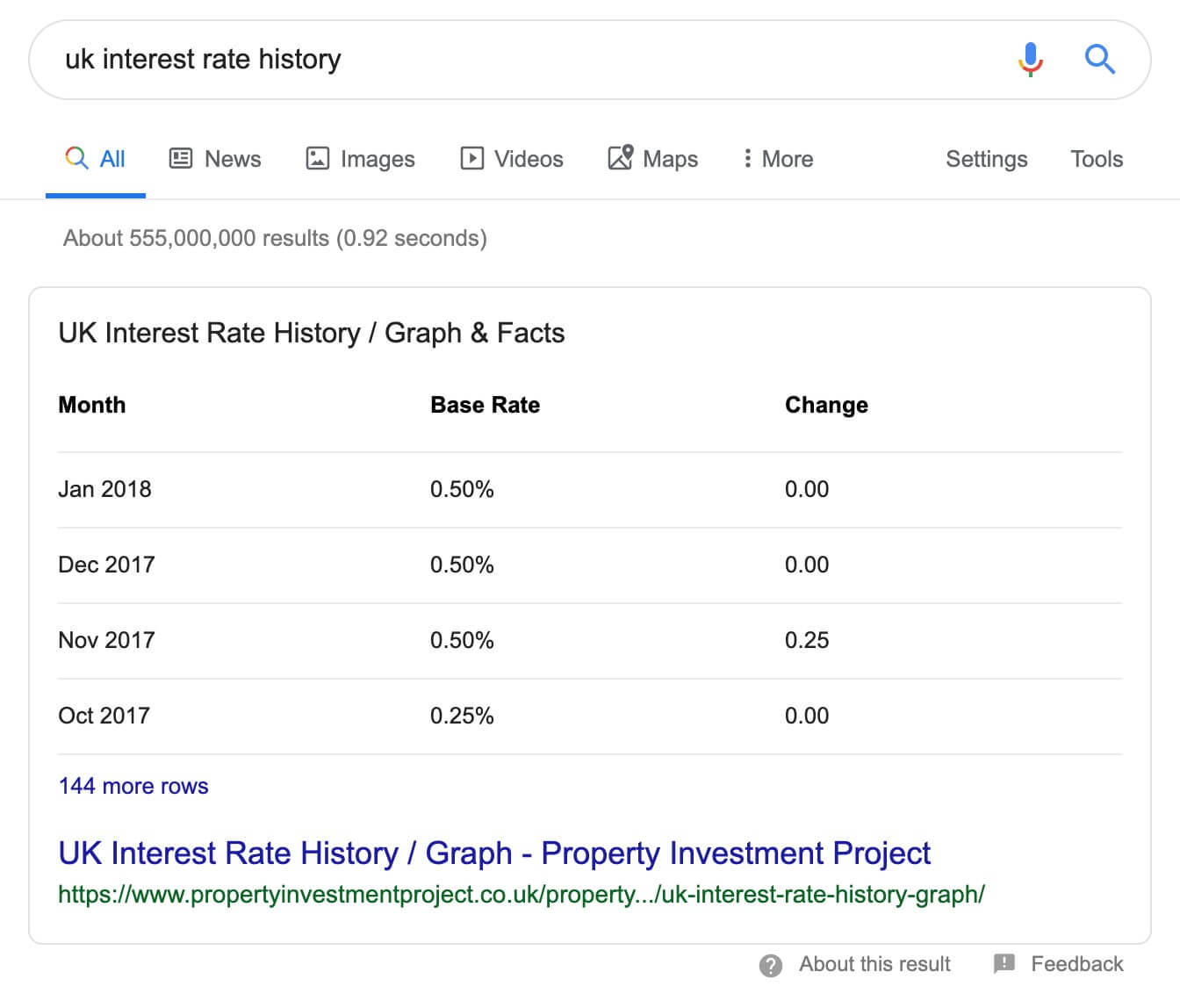
Why are featured snippets important for SEO?
As mentioned at the beginning of this article, featured snippets offer a great opportunity to increase organic traffic.
And by optimising your content to answer specific search terms, featured snippets offer the following benefits.
Position zero is the absolute top organic position
For both mobile and desktop searches, featured snippets occupy position zero, which is the first organic search result — these can only be proceeded by paid results.
The size of the screen area occupied by the result is significantly larger
The way that featured snippets appear means that they take up more visible area in the SERPs.
Include a list, picture, or video as well, and you’re bound to attract the searcher’s attention.
And it takes up an even larger proportion of the entire screen on mobile
With Google implementing a mobile-first policy for search results since March 2018, without doubt, the future of search is set for mobile devices.
As a result, the percentage of screen display that a featured snippet covers on mobile versus desktop is significantly increased.
You can have both position zero and a ‘normal’ result on the first page of the SERPs
When you have a featured snippet, you also retain your original result in the SERPs.
It is therefore common for web pages that have the featured snippet to be featured twice on page one.
Optimising your content for featured snippets will be easier than optimising your content for position one
Many studies have investigated the correlation and causation of a featured snippet.
With a user-first approach being employed by Google, it is the result that is most relevant to the search query that will get the featured snippet, not the most authoritative page.
Getting the featured snippet for a certain phrase puts you in prime position to be the one and only result for voice search
As at least 20% of mobile searches are now voice searches, voice search is thriving with the recent introduction of voice-command devices such as Alexa and Google Home.
Nothing shows the voice of authority like having a featured snippet
If a user sees your answer to their query front and centre at the top of Google, who do you think they are going to trust most?
There are few better search results that will boost your brand awareness like a featured snippet.
If you get a featured snippet, it shouldn’t be long before you see the benefit of the increased traffic.
However, it can be difficult to analyse the cause of such traffic, and attributing it to the source can be even harder.
So, how do you discover if you have featured snippets? Or even your ranking keywords where somebody else has the featured snippet?
How do I know if I have any Featured Snippets?
Right now, there is no way to identify featured snippets using any Google tools, so you’ll need to turn to third-party tools to help you out.
While this article won’t go into details on this, the closest thing to a featured snippet testing tool are the functionalities provided by the likes of both SEMrush and AHrefs.
There are also many well-written articles that can provide a step-by-step process for this
How to get a Featured Snippet on Google?
Firstly, you need to identify opportunities for content that is a likely candidate to be included in a featured snippet, based on the examples mentioned previously.
Identifying opportunities for existing content
There are two main approaches that can be taken for this task.
Third party tools will identify keywords that you rank for and where another page already has a featured snippet. These are particularly useful if you have a lot of keywords.
Alternatively, you can go through Google Search Console and identify query or question-based phrases and the pages that rank the highest and bring the most traffic.
Consider these pages for optimisation, as mentioned later on in this article.
It’s important to note at this point, if you rank for a query, there is no reason why you can’t replace an already existing featured snippet.
Identifying new content ideas for featured snippets
Alternatively, you may want to create new content.
When researching new content ideas, consider the following to improve your chances of a featured snippet.
Autocomplete is always the best place to start; giving you long tail keywords from your ‘seed’ keyword. Take these search terms and consider how they can be reworded into a query.
Find queries and questions that are already being asked in Google.
If Google can recognise what is being asked frequently, the search engine will want quality content to match these queries.
Finding existing featured snippets isn’t difficult.
By using words such as ‘how, what, why, when, where’, you are likely to find examples of featured snippets. Look for content that you think you can provide a better answer for and target those first.
How do you optimise content for featured snippets?
Optimising content for featured snippet requires two things — the right content and the right structure.
Once you have created/optimised your content to best fit the featured snippets you are aiming for, it is then time to consider the structure of your content.
When you are presenting data that could be in a featured snippet, consider the five types of featured snippets mentioned earlier.
Paragraphs
Ideal for short passages of text that answer the user query in full yet concisely.
Numbered Lists
For content that can concisely answer a user query using one paragraph, consider using a numbered list.
Split each point into a sentence or two, making sure content is concise and to the point.
Bulleted Lists
Bulleted lists can be copied directly from content into featured snippets, or they can be generated from long-form content by Google.
Where you have lots of content, make sure to break it down; relying on subheadings to identify each point you are making.
Tables
When you have content comparing or reviewing a series of items, for example, having a table with a series of row and columns can make things visually easier to compare.
While you can do this yourself, Google can also auto-generate tables for data it finds useful.
Additional Tips
Regardless of the featured snippet type you are going for; proper heading tags are essential.
Make sure to include any queries or questions that you are targeting for featured snippets, are clearly marked up with heading tags, and the resulting answer is clearly associated with the heading.
A brilliant example of this, and something that can be considered, is using a FAQs page.
Using a question as the heading followed by a paragraph as an answer allows a simple structure.
Having a comprehensive FAQs page will also generate a page full of useful content which will help SEO in other ways.
After optimising your content to provide questions and queries for the titles, you need to consider the length of the answer.
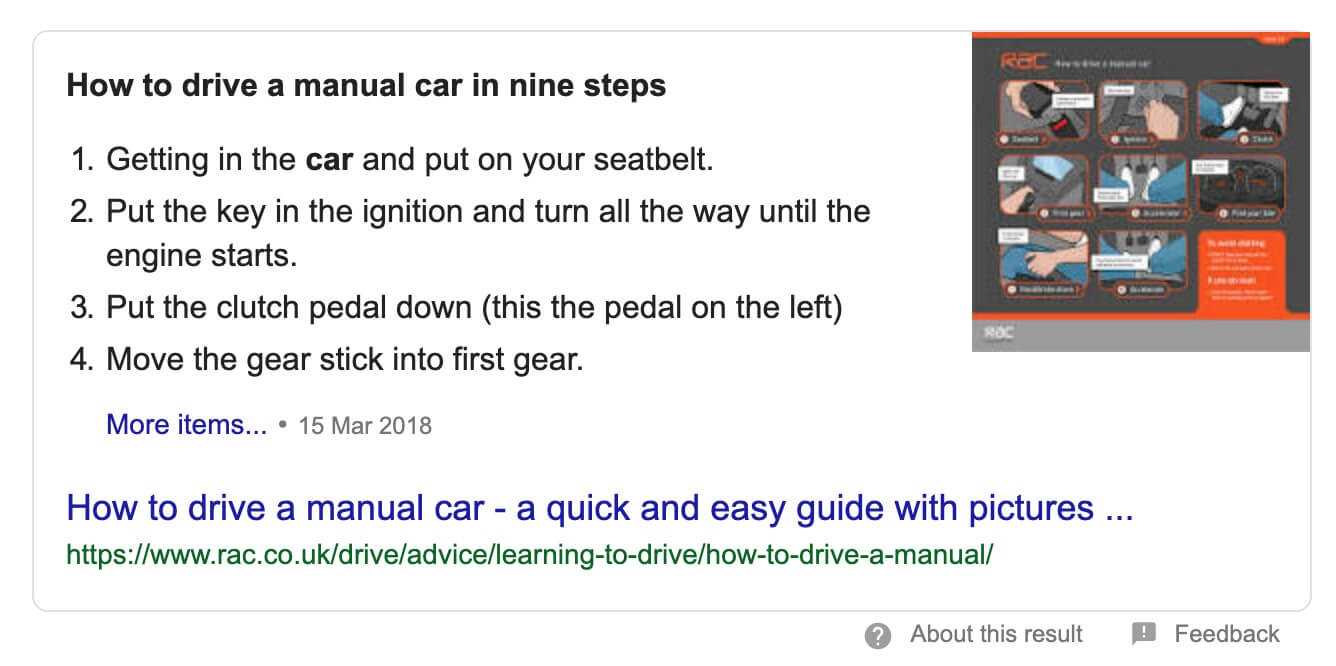
The optimum length of this answer should be between 45-60 words to be able to fit a comprehensive answer within the featured snippet box.
While Google is relatively good at picking up on the structure of your data, using simple HTML markup can help Google with rewarding you with a featured snippet.
Including data within <ol> or <ul> for numbered and bulleted lists featured snippets respectively, and <table> for table featured snippets should be a relatively simple task.
While you have to consider your content and optimise it as best you can, there is no exact formula to earn a featured snippet.
Sometimes, being patient and waiting for any changes or updates is the last step in this journey of getting a featured snippet.
Featured Snippets: Waiting for results
Whenever you make updates to pages, re-submitting URLs via GSC or webmaster tools should be done.
While there have been reports of some updates capturing the next day, realistically it is likely to take longer.
However, you don’t just optimise content for Google. Other search engines are paying attention, and as ever Bing wants a piece of the action.
What about Bing?
Anything that Google does, Bing usually has an alternative.
In this case, it seems that featured snippets on Bing are very similar to Google. Therefore, following the same optimisation tactics means you can gain featured snippets on both Google and Bing.
In fact, it seems that Bing has expanded on more focus on featured snippets, and even uses more content from the source.
What next for featured snippets?
As part of the continuous process into improving featured snippets, Google is currently trialling new features for users in the U.S.
Following on from the expandable featured snippets from Bing, Google has recently been investigating the use of double snippets.
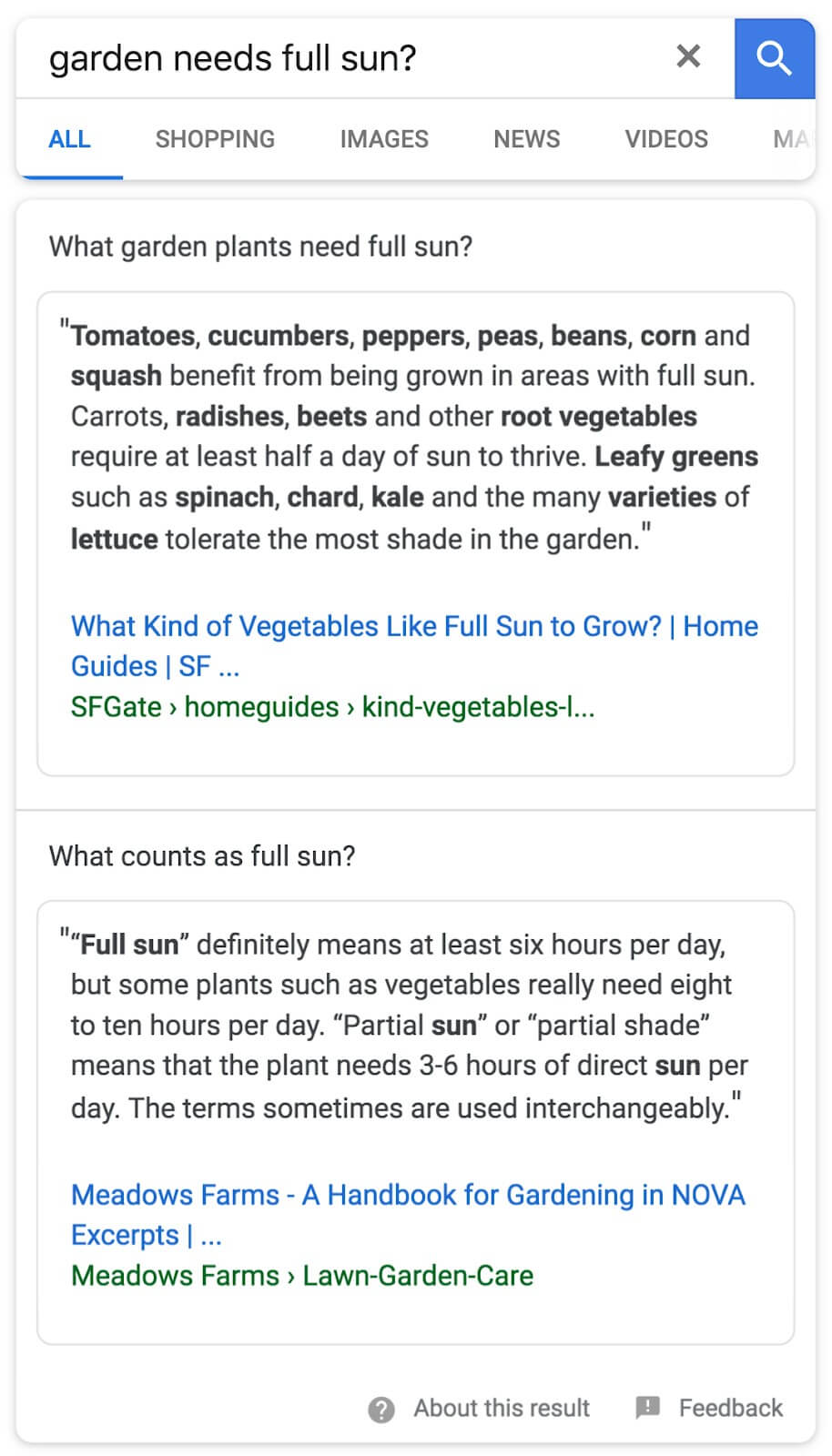
It seems that Google is focusing on providing results that have multiple or differing viewpoints.
As well as that, another trial is also investigating the addition of buttons at the top of the featured snippet, when a generic answer may not be best for the user.
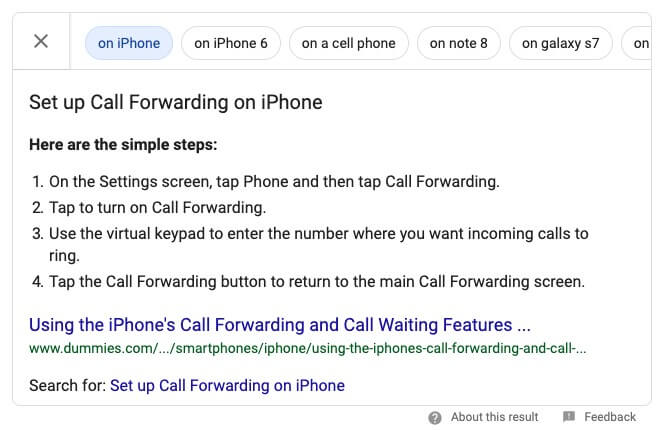
However, with the addition of types of phones along the top, it allows the user to quickly find and understand the answer Google has come back to them with.
Google has explicitly stated that featured snippets help with mobile and voice search.
A 2018 report by Search Engine land also suggests that approximately 80% of questions asked to Google Home came back with an answer that was taken from the featured snippet.
In the same blog post, Google acknowledges the difficulties and problems that featured snippets bring both to Google themselves and also to the user.
Conclusion
Now you’ve read all about featured snippets, you should be able to see the opportunities that they present to anybody working to improve their overall SEO.
Featured snippets are a great opportunity to exceed position one in the SERPs, which bring potential for increased organic traffic and brand awareness.
With the emergence of voice search always around the corner, optimising content for featured snippets is also optimising for voice search.
The formats of the current featured snippets mean there is a lot of opportunity to produce content that fits at least one of these structures, making featured snippets accessible to all webmasters.
With Google admitting the importance of featured snippets for voice and mobile search, and their continuous work to improve results to users, they are here to stay.
Producing or optimising content for featured snippets is not much more difficult than any other SEO task but should definitely be considered when implementing new content.